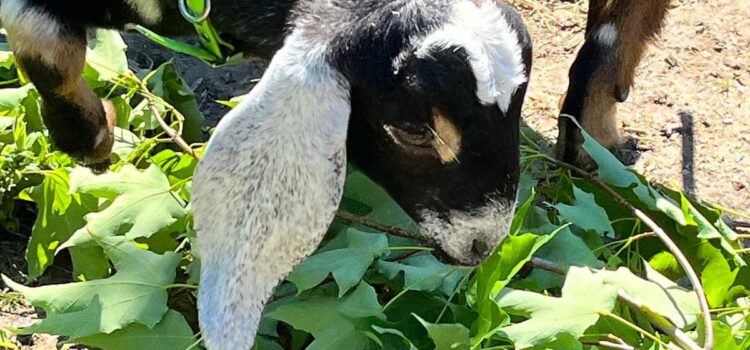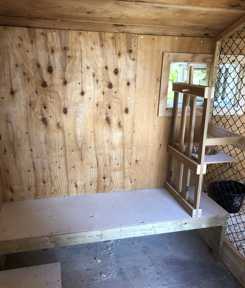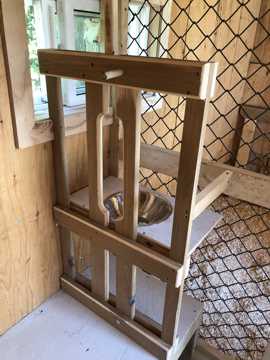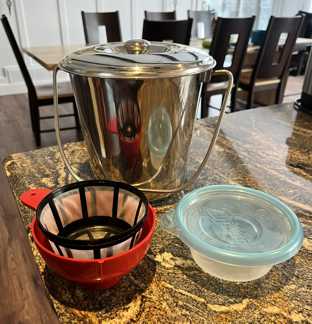
Equipment Needed:
- Milking Stand
- Dish with water and cleaner
- Reusable rags for cleaning
- Stainless steel bucket with lid
Many ask … what is your routine and time commitment for milking your goats?

Once you decide the type of goats you are looking for and you have the location of where they are going to be kept all setup (fencing … is a big one) then you can look at do you have the equipment you are going to need for milking? How are you going to milk? What will your routine be?
You will need a milking stand. Some have done it without one … but I admit I haven’t. I learned that way and it has been smooth sailing for me with it. The stand saves me, my back, and sets my routine with the goats.
My husband made me the goat stand to work within our goat building. Do I know how to build one … no. So I am thankful for a handy husband. If you are looking for building ideas for them there are lots of ideas out there to check out.
I choose to milk my goats once a day for the majority of the year. (This was a personal choice as some do milk twice a day, but I didn’t want that commitment). Why do I say the majority of the year? I personally wean my goats (dry-off) their milk supply for human consumption 2 months prior to their birthing date. This allows the mom time to just concentrate on growing those kids and keeping herself healthy. When our goats kid it is usually March or April depending on when they were bred. Depending on how many kids were born definitely affects the amount of milk. My goats have kidded from 1 kid to 4 kids per goat (definitely a range). When 4 kids were birthed (yes they are cute …) but, it can be quite hard on the mom. Usually you will end up taking some kids off and bottle-feeding them. I personally wait at least 6 weeks after the kids are born to start taking any of the milk for consumption outside of feeding the kids. Once we get to that 6 week mark milking starts again.
Milking & Kid-Sharing
I chose to milk once per day and kid-share the rest of the day. What does this mean? I will leave the kids (who I am not bottle-feeding) with the mom all day so they virtually are drinking whenever they choose during the day. At night I separate the mom and kids, so that first thing in the morning, I milk the mom (doe) for human consumption milk and then the process starts again with the kids being with mom. This is a great method for allowing you to have milk, as well as, the kids. It is also a great method if you choose to be away from home and for some reason cannot milk then you can just leave the kids with mom to have all the milk and keep the milk supply flowing.
Milking Stand

So how do I use the milking stand? It takes a bit to train your goat to go onto the stand, so definitely the process of feeding them their grain on the stand is incentive to learn to like the milking stand! I have a dish at the front of the milking stand for their grain to be added to (I don’t put the grain in there right away – once they are trained as it allows me time to clean them up etc.)
I have my goats jump on the stand. They have learned that they will be rewarded with the grain (which they love). On the milking stand there is an area which their head and neck fits between and then they are secured in this position so their head will not pull back out. Mine is secured with a dowel component. Then I move my milking stool to be by the goats.
Keeping the udders clipped on your goats will make things much easier to clean, prevent stray hairs from falling in the milk, grime from falling etc. I use horse clippers for this process and do it similar to milking in the sense that I use the milking stand and reward them with grain while I am clipping.
So prior to giving the grain I give the udder a wash. This is where my container with water, soap, and reusable cloths which I have prepped come into play. I clean each teat with a separate reusable cloth and then I use another cloth to clean each teat again. So I personally use 3 reusable cloths, per goat, to clean them up.
At this point I will put the grain in the feeder bowl for the goat. I use the top of my container that is holding the water, soap etc. to be my strip cup where I squeeze a few squirts from each teat. I do this to make sure any dirty milk is not going into my milking pail and it also gives me a chance to look at the milk and make sure there are no abnormalities.
Then I milk. My stainless steel pail is under my goat and I grasp each of the teats and begin. Everyone finds a method that works for them for milking. It is really between your thumbs and fingers to come up with a rhythm that works. You don’t have to pull hard on the teats the milk should just flow easily. I tend to put my wrist on the rim of the milking bucket just so it has something holding it while the process is occurring. Some people will milk only one teat at a time, but it definitely works easier and quicker doing two at the same time. You also are on a bit of a timeline as they will not be happy standing there once their food runs out. Don’t worry your goats will let you know if you are doing something that doesn’t work for them!

So I do this same process with my second milking goat. Depending on the time of the year the milk might fit into the same bucket … however, at peak milking season it does not, so I have to pour out my milk into another container to continue the process.
The reason I like the stainless steel lid on my bucket is it keeps it more sanitary. You are carrying the bucket to your house, this way, no extra air and debris enter the bucket. Do not delay taking your milk into the house. The next process needs to be completed quickly.
Goat milk taste will be directly related to what you feed your goat. You often hear people say my goat milk tastes “goaty”? If you let your goat out in fields where it is eating tons of weeds, cedar etc. it will affect the taste. If your goat is housed with a buck the scent from the buck will rub off on the doe. My goats are on a consistent feeding system so our milk is always consistent and does not have an odd taste.
Your milk needs to be chilled quickly to taste the best it possibly can. There is the conversation of pasteurizing your milk, vs raw milk etc. this is not something I am going to get into as those are personal choices. However, once inside my house I use an Instant-pot to lightly pasteurize my milk. I use 2 plastic coffee filter strainers within a canning funnel in which I pour my milk through. This allows all the extra debris within the milk to be caught before the pasteurization takes effect.

One it is complete I put the date on the bottles of milk and put in my fridge in the garage (coolest fridge for me).
Then your daily routine of cleaning up all your milking equipment and containers for the day take place and get ready for tomorrow.
For me this process works. Remember, your goats — your routine.
